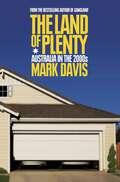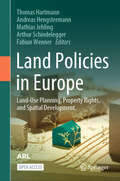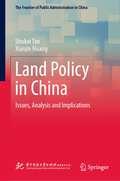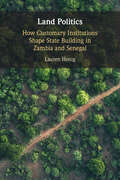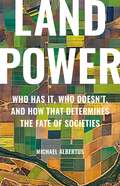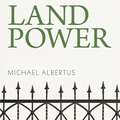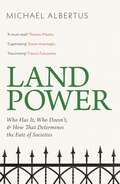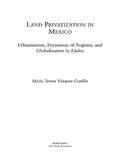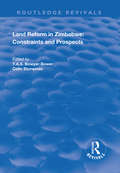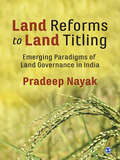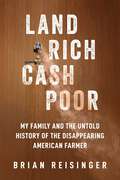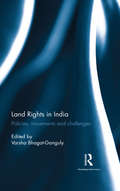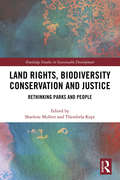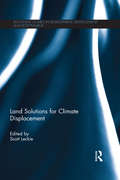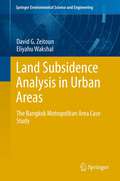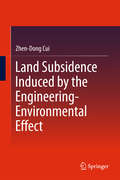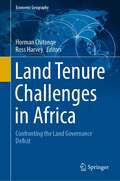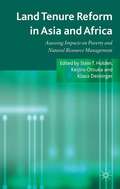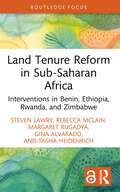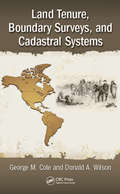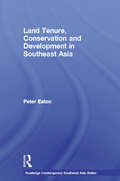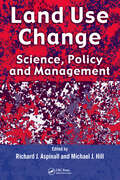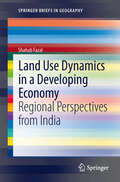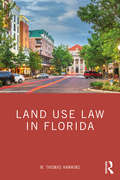- Table View
- List View
Land Of Plenty: Australia In The 2000s
by Mark Davis'There is an Australian dream that is collective. It goes to the roots of what it means to be Australian, since it's imprinted in Australia's history, the collective acts of its peoples, their attitudes, their gestures, what and how they eat, how they spend their leisure time, and the way such things reflect upon and derive from who they are.' In The Land of Plenty, Mark Davis argues that this dream has been forsaken. Over the past few decades Australians have felt the ground shift beneath their feet. Many people are asking why Australia is no longer the egalitarian place it once was. While the airwaves sing and newspaper front pages burst with news of how prosperous Australians are, many people wonder why they are working harder and longer, for so little, while important social agendas have fallen by the wayside. The Land of Plenty is at once a devastating record of the changes that have taken place in Australian society since the 1980s, and a goldmine of ideas for change. Insightful, provocative and thoroughly original, The Land of Plenty is a manifesto for our times.
Land Policies in Europe: Land-Use Planning, Property Rights, and Spatial Development
by Thomas Hartmann Andreas Hengstermann Mathias Jehling Arthur Schindelegger Fabian WennerLand is a scarce resource. How can conflicting claims to land be reconciled? How can more housing be provided and, at the same time, the ecological goal of reducing land take be met? In many European countries, land-use planning is facing increasing and oftentimes contradictory challenges. This forms a land question, which requires land policies that can deal with the fraught relationship between planning and private property rights. A legislativereflex is to adapt planning laws. Oftentimes, such changes lack a deeper reflection of land policy and its implications. Especially an international comparison can foster a structured reflection of the own land policy.This thought-provoking book compiles a remarkable collection of 12 cases unveiling how land policies work. Curated by leading experts in the field, it takes the reader on a journey through the multifaceted realm of land policies across the continent. This book offers valuable insights into the complex interplay between land use, and property rights. "Land Policies in Europe" isn't just a book; it's a conversation starter equally relevant for experienced academics or young students, policymakers, and practitioners. This is an open access book.
Land Policy in China: Issues, Analysis and Implications (The Frontier of Public Administration in China)
by Shukui Tan Xianjin HuangThis book shows the most recent changes in China’s land policy and the progress in land policy studies in terms of theory and cases. It provides an up-to-date introduction to specific land policies implemented in China, as well as an in-depth analysis of the positioning and mechanisms of these policies. It is divided into four parts with seven chapters consisting of a) introduction to land and land policy, b) overview of China’s land policy, c) typical policy issues in specific fields including land tenure, development, protection, and administration, and d) outlook of China’s land policy. With its emphasis on the importance of practice, this book not only provides readers with tools for a systematic understanding of China’s land policy practices, but also sheds light on relevant policy formulation and practice in other countries.
Land Politics: How Customary Institutions Shape State Building in Zambia and Senegal
by Lauren HonigLand Politics examines the struggle to control land in Africa through the lens of land titling in Zambia and Senegal. Contrary to standard wisdom portraying titling as an inevitable product of economic development, Lauren Honig traces its distinctly political logic and shows how informality is maintained by local actors. The book's analysis focuses on chiefs, customary institutions, and citizens, revealing that the strength of these institutions and an individual's position within them impact the expansion of state authority over land rights. Honig explores common subnational patterns within the two very different countries to highlight the important effects of local institutions, not the state's capacity or priorities alone, on state building outcomes. Drawing on evidence from national land titling records, qualitative case studies, interviews, and surveys, this book contributes new insights into the persistence of institutional legacies and the political determinants of property rights.
Land Power: Who Has It, Who Doesn't, and How That Determines the Fate of Societies
by Michael AlbertusAn award-winning political scientist shows that a society&’s path to prosperity, sustainability, and equality depends on who owns the land For millennia, land has been a symbol of wealth and privilege. But the true power of land ownership is even greater than we might think. In Land Power, political scientist Michael Albertus shows that who owns the land determines whether a society will be equal or unequal, whether it will develop or decline, and whether it will safeguard or sacrifice its environment. Modern history has been defined by land reallocation on a massive scale. From the 1500s on, European colonial powers and new nation-states shifted indigenous lands into the hands of settlers. The 1900s brought new waves of land appropriation, from Soviet and Maoist collectivization to initiatives turning large estates over to family farmers. The shuffle continues today as governments vie for power and prosperity by choosing who should get land. Drawing on a career&’s worth of original research and on-the-ground fieldwork, Albertus shows that choices about who owns the land have locked in poverty, sexism, racism, and climate crisis—and that what we do with the land today can change our collective fate. Global in scope, Land Power argues that saving civilization must begin with the earth under our feet.
Land Power: Who Has It, Who Doesn't, and How That Determines the Fate of Societies
by Michael Albertus'A must-read' THOMAS PIKETTY'Captivating' DARON ACEMOGLU'Important' FRANCIS FUKUYAMAAn award-winning political scientist shows that a society's path to prosperity, sustainability, and equality depends on who owns the land.For millennia, land has been a symbol of wealth and privilege. But the true power of land ownership is even greater than we might think. In Land Power, political scientist Michael Albertus shows that who owns the land determines whether a society will be equal or unequal, whether it will develop or decline, and whether it will safeguard or sacrifice its environment. Modern history has been defined by land reallocation on a massive scale. From the 1500s on, European colonial powers and new nation-states shifted indigenous lands into the hands of settlers. The 1900s brought new waves of land appropriation, from Soviet and Maoist collectivization to initiatives turning large estates over to family farmers. With the establishment of cooperatives in North Africa, the displacement of Native Americans and divisive inheritance laws of post-partition India, land decisions reverberate to this day as governments vie for power and prosperity by choosing who should get land. Drawing on a career's worth of original research and on-the-ground fieldwork, Albertus shows that choices about who owns the land have locked in poverty, sexism, racism, and climate crisis-and that what we do with the land today can change our collective fate. Global in scope, Land Power argues that saving civilization must begin with the earth under our feet.
Land Power: Who Has It, Who Doesn't, and How That Determines the Fate of Societies
by Michael Albertus'A must-read' THOMAS PIKETTY'Captivating' DARON ACEMOGLU'Important' FRANCIS FUKUYAMAAn award-winning political scientist shows that a society's path to prosperity, sustainability, and equality depends on who owns the land.For millennia, land has been a symbol of wealth and privilege. But the true power of land ownership is even greater than we might think. In Land Power, political scientist Michael Albertus shows that who owns the land determines whether a society will be equal or unequal, whether it will develop or decline, and whether it will safeguard or sacrifice its environment. Modern history has been defined by land reallocation on a massive scale. From the 1500s on, European colonial powers and new nation-states shifted indigenous lands into the hands of settlers. The 1900s brought new waves of land appropriation, from Soviet and Maoist collectivization to initiatives turning large estates over to family farmers. With the establishment of cooperatives in North Africa, the displacement of Native Americans and divisive inheritance laws of post-partition India, land decisions reverberate to this day as governments vie for power and prosperity by choosing who should get land. Drawing on a career's worth of original research and on-the-ground fieldwork, Albertus shows that choices about who owns the land have locked in poverty, sexism, racism, and climate crisis-and that what we do with the land today can change our collective fate. Global in scope, Land Power argues that saving civilization must begin with the earth under our feet.
Land Privatization in Mexico: Urbanization, Formation of Regions and Globalization in Ejidos
by Maria Teresa Vázquez-CastilloThis book analyzes [ejido] land as space of urbanization and location of economic activities and capital and land privatization as a redistributive process with local, urban, regional and global consequences.
Land Reform in Zimbabwe: Constraints And Prospects (Routledge Revivals)
by Colin StonemanThis title was first published in 2000. Drs Tanya Bowyer-Bower and Colin Stoneman compile the views of top researchers, members of Government, civil society, NGOs, funders, and Zimbabwe’s three farmers’ unions. The history of land reform in Zimbabwe is addressed and the current proposed reform policies, comparison between programmes elsewhere in Southern Africa, and implications including for rural and urban welfare, the economy, the environment, the law, and for women. The result is an invaluable overview of this crucial and contentious issue, including constructive suggestions for consensual ways forward.
Land Reforms to Land Titling: Emerging Paradigms of Land Governance in India
by Pradeep NayakIn India, land policies have been undergoing a paradigm shift since the economic reforms of the early 1990s. Conclusive land titling or guaranteed title to land has emerged as an alternative policy option to the redistributive land reform agenda before economic liberalization, and marks a historic reorientation of land policy. Land Reforms to Land Titling: Emerging Paradigms of Land Governance in India studies this reorientation. Would the neoliberal policy of secure individual property rights in land address diverse land-related questions in India? Whose interests will a conclusive titling policy serve, given unequal land holdings? How are capitalist or market imperatives of efficiency and growth bypassing social concerns? This book addresses these and other important questions through an in-depth study of not only India’s land governance history but also the experiences of other developing countries. The book also talks about policy implications and will be an invaluable read for academics and policymakers alike.
Land Rich, Cash Poor: My Family's Hope and the Untold History of the Disappearing American Farmer
by Brian ReisingerThe hidden history of an economic and cultural crisis that is threatening our very food supply—the disappearance of the American farmer. Taking on this working-class story of heart and hardship, award-winning writer Brian Reisinger weaves forgotten eras of American history with his own family&’s four-generation fight for survival in Midwestern farm country. Readers learn the truth about America&’s most detrimental and unexplained socioeconomic crisis: How the family farms that feed us went from cutting a middle-class path through the Great Depression to barely making ends meet in modern America. Along the way, they&’ll see what it truly takes to feed our country: accidents that can kill or maim; weather that blesses or threatens; resilience in the face of crushing economic crises, from depressions and recessions to COVID-19; and the tradition that presses down on each generation when you're not just fighting for your job, you're fighting for your heritage. With newly analyzed data, sharp historical analysis, conversations with some of modern farming&’s most notable champions and critics alike, honest debate, and personal storytelling, Reisinger reveals how the hollowing out of rural America is affecting every single American dinner table. Food prices soaring far beyond the rate of inflation, a vulnerable food supply chain, environmental and ecological dilemmas, the security of our farmland from foreign adversaries, a mental health crisis that includes farmer suicides and addictions, a deepening urban-rural divide, and more worries than ever about what&’s for dinner. These are all becoming the hallmarks of a food system that has long stood as a modern miracle. Land Rich, Cash Poor offers the honest truth about these issues, and a candid look at what we can do about them—before it&’s too late.
Land Rights in India: Policies, movements and challenges
by Varsha Bhagat-GangulyThis volume engages with the topical issue of land rights in neoliberal India. It examines government policies, laws, land governance and land reforms from the perspective of social justice and people’s response to dispossession of land. Looking beyond the dominant discourse of land acquisition and the conception of land as a commodity for economic growth, the book explores critical themes including issues of social identity, culture, livelihood and food security through a study of land reform; reviews existing land policies and legal dimensions; and discusses issues and challenges of land governance and land dependents as well as perspectives from people’s movements. Lucidly written, based on empirical research, and comprehensive in its treatment of a contentious concern, this volume will be useful to scholars and researchers of economics and public policy, development studies, political science, and political economy. It will also interest scholars of South Asian studies and sociology.
Land Rights, Biodiversity Conservation and Justice: Rethinking Parks and People (Routledge Studies in Sustainable Development)
by Sharlene Mollett Thembela KepeIn the context of sustainable development, recent land debates tend to construct two porous camps. On the one side, norms of land justice and their advocates dictate that people’s rights to tenure security are tantamount and even sometimes key to successful conservation practice. On the other hand, biodiversity protection and conservation advocates, supported by global environmental organizations and states, remain committed to conservation strategies, steeped in genetics and biological sciences, working on behalf of a "global" mandate for biodiversity and climate change mitigation. Land Rights, Biodiversity Conservation and Justice seeks to illuminate struggles for land and territory in the context of biodiversity conservation. This edited volume explores the particular ideologies, narratives and practices that are mobilized when the agendas of biodiversity conservation practice meet, clash, and blend with the demands for land and access and control of resources from people living in, and in close proximity to, parks. The book maintains that, while biodiversity conservation is an important goal in a time where climate change is a real threat to human existence, the successful and just future of biodiversity conservation is contingent upon land tenure security for local people. The original research gathered together in this volume will be of considerable interest to researchers of development studies, political ecology, land rights, and conservation.
Land Solutions for Climate Displacement (Routledge Studies in Development, Displacement and Resettlement)
by Scott LeckieThe threat of climate displacement looms large over a growing number of countries. Based on the more than six years of work by Displacement Solutions in ten climate-affected countries, academic work on displacement and climate adaptation, and the country-level efforts of civil society groups in several frontline countries, this report explores the key contention that land will be at the core of any major strategy aimed at preventing and resolving climate displacement. This innovative and timely volume coordinated and edited by the Founder of Displacement Solutions, Scott Leckie, examines a range of legal, policy and practical issues relating to the role of land in actively addressing the displacement consequences of climate change. It reveals the inevitable truth that climate displacement is already underway and being tackled in countries such as Bangladesh, Kiribati, Papua New Guinea, Solomon Islands, Tuvalu and the United States, and proposes a series of possible land solution tools that can be employed to protect the rights of people and communities everywhere should they be forced to flee the places they call home.
Land Subsidence Analysis in Urban Areas
by David G. Zeitoun Eliyahu WakshalCities built on unconsolidated sediments consisting of clays, silt, peat, and sand, are particularly susceptible to subsidence. Such regions are common in delta areas, where rivers empty into the oceans, along flood plains adjacent to rivers, and in coastal marsh lands. Building cities in such areas aggravates the problem for several reasons: 1. Construction of buildings and streets adds weight to the region causing additional soil deformations. 2. Often the regions have to be drained in order to be occupied. This results in lowering of the water table and leads to hydro-compaction. 3. Often the groundwater is used as a source of water for both human consumption and industrial use. 4. Levees and dams are often built to prevent or control flooding. Earth fissures caused by ground failure in areas of uneven or differential compaction have damaged buildings, roads and highways, railroads, flood-control structures and sewer lines. As emphasized by Barends , "in order to develop a legal framework to claims and litigation, it is essential that direct and indirect causes of land subsidence effects can be quantified with sufficient accuracy from a technical and scientific point of view." Most existing methods and software applications treat the subsidence problem by analyzing one of the causes. This is due to the fact that the causes appear at different spatial scales. For example, over-pumping creates large scale subsidence, while building loading creates local subsidence/consolidation only. Then, maximum permissible land subsidence (or consolidation) is a constraint in different management problems such as: groundwater management, planning of town and/or laws on building construction. It is, therefore, necessary to quantify the contribution of each cause to soil subsidence of the ground surface in cities urban area. In this text book, we present an engineering approach based on the Biot system of equations to predict the soil settlement due to subsidence, resulting from different causes. Also we present a case study of The Bangkok Metropolitan Area (BMA).
Land Subsidence Induced by the Engineering-Environmental Effect
by Zhen-Dong CuiThis book brings forward the concept of the geology-environmental capacity of ground buildings. It quantifies the geology-environmental capacity of ground buildings by analyzing the main factors of land subsidence and setting up the evaluation system. The geological environmental capacity of ground buildings is mainly controlled by the land subsidence and the output is the floor area ratio. According to the different geology structures and the different requirements of subsidence control in the soft soil areas in Shanghai, the evaluation system of the floor area ratio is built up by the adaptive neuro-fuzzy inference system (ANFIS) and the floor area ratios of four typical regions (Lujiazui, Xujiahui, Zhongyuan and Changqiao) are obtained by the ANFIS to offer references for urban planning. By taking the typical soft soil areas in Shanghai as case studies, this book will provide valuable insights to professors and graduate students in the field of Geotechnical Engineering, Civil Engineering, Engineering Geology and Environmental Geology.
Land Tenure Challenges in Africa: Confronting the Land Governance Deficit (Economic Geography)
by Horman Chitonge Ross HarveyThis book provides a significant contribution to the literature on land reform in various African contexts. While the economic evidence is clear that secure property rights are a necessary condition for catalysing broad-based economic development, the governance process by which those rights are secured is less clear. This book details the historical complexity of land rights and the importance of understanding this history in the process of trying to improve tenure security. Through a combination of single country case studies, comparative case studies and regional comparisons, the book is unequivocal that good governance is paramount for improving the performance of land reform programmes. All attempts at moving towards more formal secure tenure require congruence with informal norms, beliefs and values, and a set of clear systems and processes to avoid corruption and unintended negative consequences.
Land Tenure Reform in Asia and Africa
by Klaus Deininger Keijiro Otsuka Stein T. HoldenRural poverty remains widespread and persistent in South Asia and Sub-Saharan Africa. A group of leading experts critically examines the impact of land tenure reforms on poverty reduction and natural resource management in countries in Africa and Asia with highly diverse historical contexts.
Land Tenure Reform in Sub-Saharan Africa: Interventions in Benin, Ethiopia, Rwanda, and Zimbabwe (Routledge Focus on Environment and Sustainability)
by Steven Lawry Rebecca McLain Margaret Rugadya Gina Alvarado Tasha HeidenrichThis book examines the impacts of land tenure reform interventions implemented in Benin, Ethiopia, Rwanda, and Zimbabwe. Since 2000, many African countries have introduced programs aimed at providing smallholder farmers with low-cost certificates for land held under customary tenure. Yet there are many contending views and debates on the impact of these land policies and this book reveals how tenure security, agricultural productivity, and social inclusion were affected by the interventions. It analyses the results of carefully selected, authoritative studies on interventions in Benin, Ethiopia, Rwanda, and Zimbabwe and applies a realist synthesis methodology to explore the socio-political and economic contexts. Drawing on these results, the book argues that inadequate attention paid to the core characteristics of rural social systems obscures the benefits of customary tenure while overlooking the scope for reforms to reduce the gaps in social status among members of customary communities. This book will be of great interest to students and scholars of land management and use, land and property law, tenure security, agrarian studies, political economy, and sustainable development. It will also appeal to development professionals and policymakers involved in land governance and land policy in Africa.
Land Tenure, Boundary Surveys, and Cadastral Systems
by Donald A. Wilson George M. ColeLand is important to all aspects of human life and has a key role in the economic well-being of society therefore, land tenure, land ownership, and real property law is a critical part of any developed nation. Together, the processes of how land parcels are held; how they are defined, measured, and described to allow economic transactions; how they are marked to allow their use and defense; and how they are legally protected have allowed for the orderly possession and use of land. In doing so, these processes have also provided the basis for the advanced economy of most developed nations. Very often, these processes—land tenure, boundary surveying, and cadastral systems—are considered separately. They are very much interrelated, and none of these processes may be completely understood without an understanding of the others. Land Tenure, Boundary Surveys, and Cadastral Systems provides an introduction to land tenure, cadastral systems, and boundary surveying, including an understanding of the interrelationship of these areas and their role in land tenure and real property law. This is especially true considering the advent of georeferenced cadastral maps reflecting the location of land parcels relative to many other components of the physical and legal infrastructure. Although intended as a basic text for college-level surveying courses, this book should also be of significant value to cadastral mappers, real property attorneys, land title professionals, and others involved with land transactions.
Land Tenure, Conservation and Development in Southeast Asia (Routledge Contemporary Southeast Asia Series #Vol. 1)
by Peter EatonThis book examines the relationship between land tenure, conservation and rural development in the context of the Southeast Asian archipelago. In particular, it is concerned with people living in and around national parks and other protected areas. It discusses the value of reinforcing indigenous tenure and sustainable resource use practices and of including them in policies and projects that attempt to integrate conservation and development.
Land Use Change: Science, Policy and Management
by Michael J. Hill Richard J. AspinallChanges in the use of land reflect a variety of environmental and social factors, necessitating an equally varied suite of data to be used for effective analysis. While remote sensing, both from satellites and air photos, provides a central resource for study, socio-economic surveys, censuses, and map sources also supply a wealth of valid informati
Land Use Dynamics in a Developing Economy
by Shahab FazalToday, India still remains a rural agricultural country although the share of urban population has also increased but these figures do not tell the whole story. There are evidences that urban growth is dispersed and urban sprawl promotes the spread of urban land use into the rural-urban fringe. Here the attempt is to investigate the land transformation and the driving forces which were influencing the land transformation. The present study was done on peri urban interface of Aligarh city, a relatively small city, but as other north Indian cities, it is also expanding rapidly. Moreover, it too is surrounded by a populous rural area with productive and rich agricultural hinterland. Such conditions give rise to many conflicts and mutually beneficial complementarities in the rural and urban spheres. The result shows that the demand for land is high which results in informal urban development fulfilling the requirements of many of the city's residents. Every piece of land is a tradable commodity, and the pursuit of short-term profits is the predominant ethic. The actors in PUI are strong because it is characterized by intermixing of rural and urban activities and interests as well as the number of actors are greater than in any other area. .
Land Use Law and Disability
by Robin Paul MalloyIn Land Use Law and Disability, Robin Paul Malloy argues that our communities need better planning to be safely and easily navigated by people with mobility impairment and to facilitate intergenerational aging in place. To achieve this, communities will need to think of mobility impairment and inclusive design as land use and planning issues, in addition to understanding them as matters of civil and constitutional rights. Although much has been written about the rights of people with disabilities, little has been said about the interplay between disability and land use regulation. This book undertakes to explain mobility impairment, as one type of disability, in terms of planning and zoning. The goal is to advance our understanding of disability in terms of planning and zoning to facilitate cooperative engagement between disability rights advocates and land use professionals. This in turn should lead to improved community planning for accessibility and aging in place.
Land Use Law in Florida
by W. Thomas HawkinsLand Use Law in Florida presents an in-depth analysis of land use law common to many states across the United States, using Florida cases and statutes as examples. Florida case law is an important course of study for planners, as the state has its own legal framework that governs how people may use land, with regulation that has evolved to include state-directed urban and regional planning. The book addresses issues in a case format, including planning, land development regulation, property rights, real estate development and land use, transportation, and environmental regulation. Each chapter summarizes the rules that a reader should draw from the cases, making it useful as a reference for practicing professionals and as a teaching tool for planning students who do not have experience in reading law. This text is invaluable for attorneys; professional planners; environmental, property rights, and neighborhood activists; and local government employees who need to understand the rules that govern how property owners may use land in Florida and around the country.
